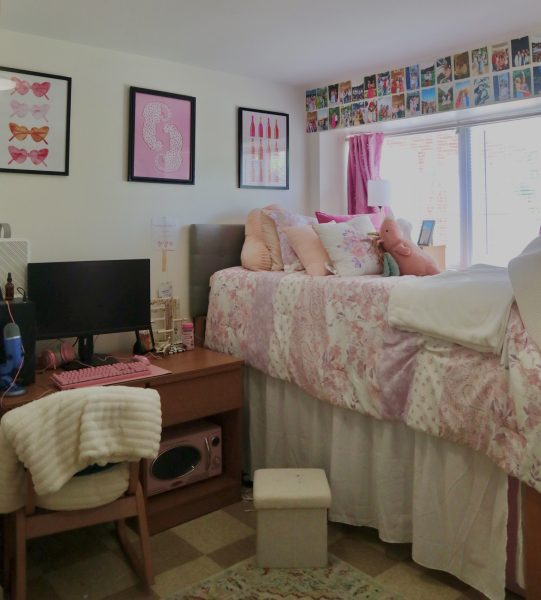For students living on-campus, dorms can be a difficult space to decorate – cramped layouts, standard-issue furniture and a cream-colored, wood-veneer color palette can leave little room for personal expression. But this fall at GCSU students got creative, bringing some of their favorite craft projects and retail finds to transform residence halls into spaces that feel more like home.
LillyAnn Hancock, a freshman living on West Campus, used a cork board craft project to bring warmth and familiarity to her new room.
“I have a big cork board that I decorated right before move-in that has a bunch of pictures of my friends from home and my family. I decorated it to be really aesthetic and match my room,” said Hancock.
In addition to her cork board project, Hancock shopped at a variety of stores to round out her decorations. While residence hall room comes furnished with an extra-long twin size bed, desk and chair, dresser and bookshelf, all other furnishings are left up to students to provide.
“I got some stuff at Walmart, Hobby Lobby, Target – especially Target, I love Target – and the At Home store,” said Hancock.
Bella Barksdale, a freshman nursing major, said her roommate used craft materials to make their dorm door personalized.
“My roommate made us little minion name-tag things to put on the outside of our dorm – so we have like, Bob and Stewart, on the outside of our door,” said Barksdale.
When it came to hanging decorations, Barksdale had to navigate the same housing policies that apply to all students. “We used a lot of command hooks – or we tried to, and only some stayed up, and we used really tiny nails,” she said.
As students decorate their rooms, they also have to keep in mind university housing policies and restrictions designed to prevent damage charges and ensure safety. While students are encouraged to personalize their rooms or apartments, University Housing outlines clear guidelines about what materials can and cannot be used.
According to the Georgia College University Housing and Residence Life Policy Handbook, “Wall hangings, large nails, screws, bolts, wall anchors, and double-sided tape on the walls, furniture or fixtures are prohibited. 3M hooks/Command strips or similar products may be used to affix things to the walls.”
Students are also permitted to use small tacks to hang lightweight decorations and over-the-door hangers provide another safe option without risking paint damage.
“My roommate has these sticky hooks that you can put up on the wall, and I think those work really well,” Hancock shared.
This year’s handbook also encourages students to check in with their Community Advisor (CA) or Community Director (CD) if they have any questions or concerns about their decorations. It cautions against do-it-yourself repairs, such as patching or painting over damage, as these can result in additional charges if staff determine that attempts were made to conceal wall or furniture issues.
Even with restrictions in place, there are plenty of creative ways for students to make their dorms feel welcome while adhering to housing guidelines. Beyond brightening up the space, decorations can also help ease the transition from home to campus life. For many students, the simple act of hanging photos, stringing lights or setting up a favorite blanket or rug provides the comfort of home in a new environment.
“I brought my baby blanket from home, so just having that little piece of comfort in my bed,” said Barksdale.
Students often bring both practical items for community living, such as microwaves, mini fridges and cleaning supplies, as well as decorative furnishings like wall art, curtains, rugs and extra seating such as chairs or futons. Together, these pieces help transform bare residence hall dorms into personalized spaces that reflect the personalities and needs of the students who call them home.


